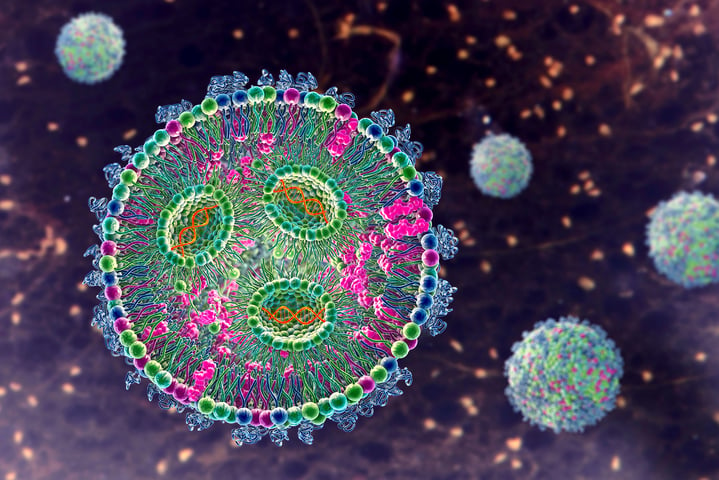
Lipid nanoparticles (LNPs) have turned out to be very successful carriers for efficient delivery of various categories of drugs. Needless to say, the LNP-based COVID-19 messenger RNA (mRNA) vaccines are probably the most well-known ones. Despite the success of LNP—based drugs, however, there is still room for improvement. One aspect that could be improved is the degree of cellular uptake in the body once the drug is injected. The degree of uptake varies and needs to be evaluated. Current methods used for this assessment are both time-consuming and expensive but there is research ongoing in the area to identify more efficient ways.
Curious to learn more about how QSense QCM-D is used in this research, I reached out to Federica Sebastiani, Tenure Track Assistant Professor at the Department of Pharmacy, University of Copenhagen. The focus of Prof. Sebastiani’s research is on physico-chemical characterization of self-assembled soft matter systems, and in particular on lipid-based systems. She is interested in the relationship between the structure and function of lipid assembly for drug delivery, i.e. LNPs for mRNA delivery. In parallel, she is interested in studying these systems when interacting with proteins and/or model membranes. By understanding the relationship between structure and function of bio-colloids and biomimetic systems, she aims to control function by tuning structure.
In 2022, Prof. Sebastiani, at the time post-doc in the group of Prof. Marité Cárdenas at Malmö University, conducted a study1 to investigate the binding affinity of serum proteins to lipid nanoparticles in a cell-free environment. In the study, she and the research team propose a time and cost-effective method to screen a wide range of LNP formulations and select the most promising candidates for in vitro and in vivo studies. This is what Prof. Sebastiani said in an interview about the study.
There was a hypothesis that LNP surface structure/composition was playing a role in the binding of Apolipoprotein E (ApoE), and that higher binding would result in more efficient cellular uptake via LDL-receptor and hence higher protein expression, Prof. Sebastiani says. In this study, I wanted to address the question about binding affinity of ApoE to mRNA-LNPs as a function of LNP composition. QCM-D was the technique of choice for the study since it provides large flexibility with functionalization strategies and the possibility to follow in real-time the interaction of serum proteins with immobilized LNPs.
The approach was to design a functionalization for the QCM-D sensor which would allow for immobilization of LNPs and then measurement of the protein binding in a semi-quantitative way, Prof. Sebastiani says. The key component of the functionalization was the antiPEG antibody that ensured immobilization of LNPs at the surface. The functionalization allowed us to make a reproducible and stable particle layer. This layer was then exposed to different protein concentrations.
The analysis of the QCM-D data was fundamental to obtain reliable results. Our choice was to extrapolate the equivalent thickness from the plot -ΔD/Δf vs -Δf.
The main result from the study is that different LNP formulations show a different binding affinity to ApoE, and we found that higher binding affinity correlates with higher protein expression in cells,2 Prof. Sebastiani says. This confirms the hypothesis that ApoE is key in the cellular uptake of LNPs when administered intravenously. Hence the method can be used to screen LNP formulation for ApoE binding affinity and restrict in vitro study to the most promising formulations.
The work combines QCM-D with a tailored functionalisation of gold sensors resulting in a powerful tool to investigate protein-lipid nanoparticles binding affinity. The method can be applied to a range of lipid-based particles and interacting molecules, and the development of the method itself is a contribution to the field. It will allow for studies of particle-protein interaction in a cell-free environment, Prof. Sebastiani says.
This study provided the missing information to link ApoE binding affinity to LNPs to their protein expression, Prof. Sebastiani says. And, as mentioned earlier, QCM-D was the key technique in this work, giving us the possibility to develop a platform that can be used to investigate other questions on particle-protein interaction, Prof. Sebastiani concludes.
Learn best practices and step-by-step methods for accurate QCM-D coating thickness measurement on QSense sensors using QSense Omni.
Compared to QCM, QCM-D measures an additional parameter, and provides more information about the system under study.
Discover how QCM-D analysis reveals real-time etching dynamics, helping optimize cleaning processes and protect surfaces from unwanted damage.
Discover how QSense QCM-D helps tackle fouling challenges across industries
Discover how QCM-D enables real-time, label-free analysis of supported lipid membrane formation, structure, and dynamics for advanced research
Learn how QSense QCM-D analysis can reveal membrane fouling dynamics and optimize cleaning strategies for more efficient water treatment
Learn how QSense QCM-D helps detect and prevent surface-induced instabilities in biologics. Join our webinar for insights and practical examples.
Learn about the top QSense sensors for analyzing biopharmaceutical drug-surface interactions in the context of IV bags.
Learn about QCM-D, Quartz Crystal Microbalance with Dissipation monitoring - an analytical tool for surface interaction studies at the nanoscale.
Explore QSense QCM-D sensors to optimize cleaning efficiency with real-time insights, enhancing formulations and protocols across various conditions.
Learn how how run small volume measurements with QSense Omni
Learn about of the acoustic technology, QCM-D, via musical instrument analogies.
